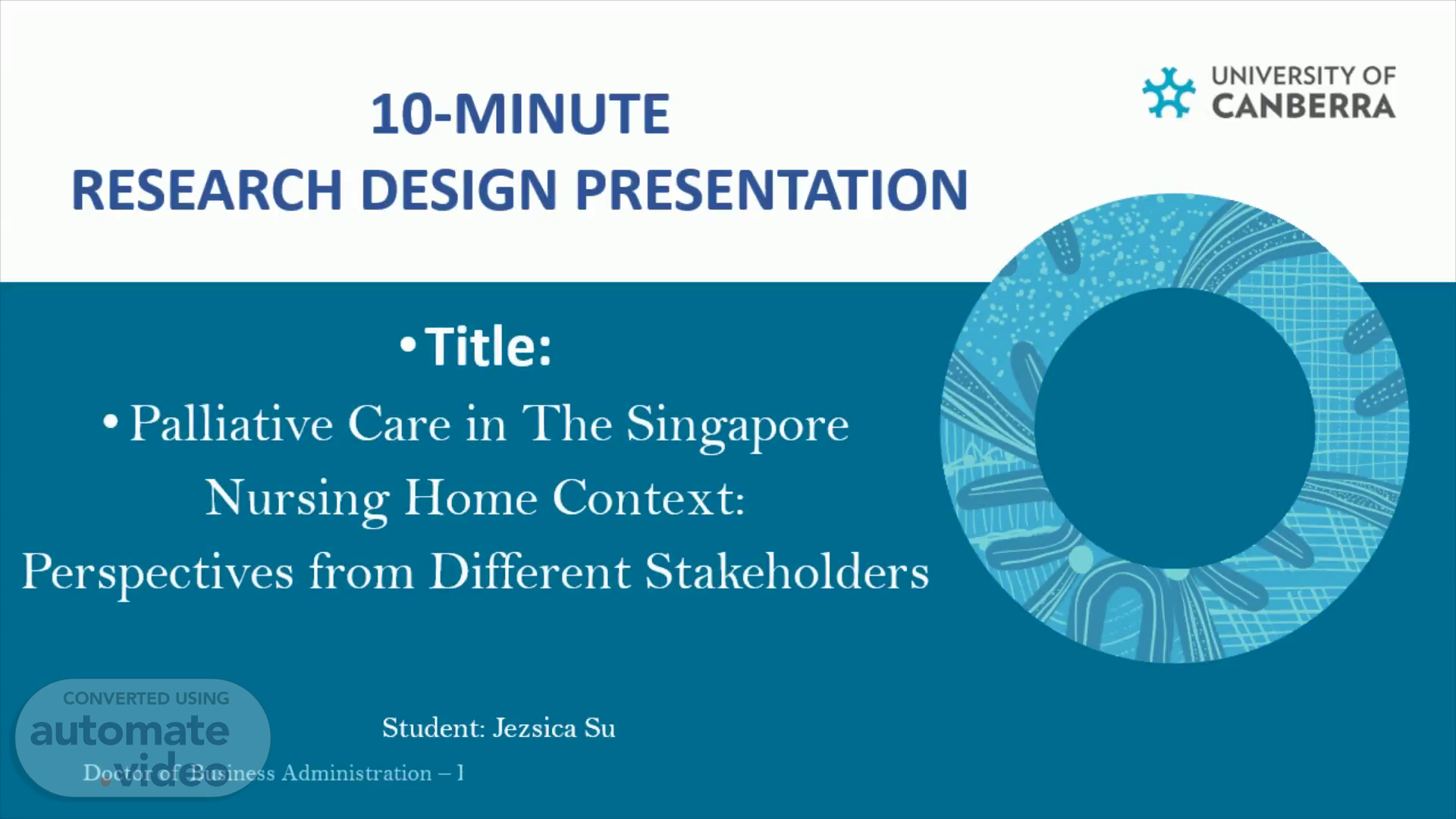
PowerPoint Presentation
Scene 1 (0s)
10-MINUTE RESEARCH DESIGN PRESENTATION. Student: Jezsica Su.
Scene 2 (8s)
BACKGROUND. Aging population (Department of Statistics Singapore) Demographic shifts (Chang et al, 2017; Exley & Allen, 2007) Lack of caregiver (Chang et al, 2017) Need for institutionalized care Common place of death care homes (Arya, 2020; Bone et al, 2017). Chronic diseases can benefit from palliative care (Chiang, Wu and Peng, 202’; World Health Organisation , 2011) Inadequately provided in nursing homes (Arya, 2020; Macgregor et al., 2021). Aim: To explore the experiences of health care providers and care recipients in palliative care needs in nursing homes.
Scene 3 (1m 1s)
KEY PROBLEMS AND RESEARCH AIMS. Key problems Resources have not grown to meet the demand for palliative care in nursing homes Residents spent their last weeks in tertiary/secondary hospitals.
Scene 4 (2m 18s)
RESEARCH AIMS. Aims: Gain an insight into the importance and role that nursing home staff can play in enabling a holistic approach to palliative care encompassing psychosocial, emotional and spiritual aspects in addition to symptom management Explore the concept of palliation by a trusted environment and human relationship between residents and care staff as important factors for the well-being of NH residents To explore the perceptions of stakeholders on how they recognize and respond to residents’ needs.
Scene 5 (2m 52s)
RESEARCH QUESTIONS. What are the perceptions of stakeholders that influence current nursing home practice and service provision that promotes or inhibits the integration of palliative care as part of nursing home care? What are the experiences and relationships of residents with care staff towards their care in the nursing home?.
Scene 6 (3m 24s)
RESEARCH APPROACH. Exploratory study Qualitative Design of inquiry - Phenomenology research.
Scene 7 (3m 52s)
POPULATION AND SAMPLING METHOD. Participants Care Providers Nurses Doctors Administrators Care Recipients Residents Family members Across a few not-for-profit and public nursing homes in Singapore Purposive sample Snowballing sampling method.
Scene 8 (4m 24s)
DATA COLLECTION METHOD. Methods Participants Rationale Focus Group Discussions Doctors Nurses Administrators Allows in-depth information and discussion from a group of people about their experiences and perceptions Produce greater insight into the problem under discussion Interviews Residents Family members More in-depth information and understand their experiences Answer in their own words Expand or clarify responses Observation All Take detailed notes Record relevant observations.
Scene 9 (5m 56s)
DATA COLLECTION PROCEDURES. 4 criteria (Lincoln and Guba, 1985) Credibility Transferability Dependability Confirmability Data management plan.
Scene 10 (7m 27s)
DATA ANALYSIS. Qualitative data analysis Dense data Interpret meanings Identify patterns Extract relevant parts Thematic analysis Content of the data Identify key themes.
Scene 11 (8m 9s)
RISK ASSESSMENT AND MITIGATION. Institutional review board (IRB) approval.
Scene 12 (9m 47s)
TIMEFRAMES FOR PROJECT COMPLETION. YEAR MONTH ACTIVITIES 2021 August - October Coursework: 10386 Research Fundamentals Coursework: 10387 Reading and Critiquing 2022 February to May Coursework: 10388 Research Design Coursework: 10389 Current Research Issues in Business March Introductory Seminar April to May Thesis Writing – Chapter 1 June to August Thesis Writing – Chapter 2 September Confirmation Seminar August to October Thesis Writing – Chapters 3 October to December Data Collection 2023 January to March Thesis Writing – Chapter 4 April to June Data Analysis July to September Thesis Writing – Chapter 5 October to November Thesis Writing – Chapter 6 December Break 2024 January to March Thesis Writing – Chapter 7 April to June Thesis Writing – Chapter 8 July Thesis Draft and Revision August Thesis Submission.
Scene 13 (9m 51s)
REFERENCES. Arya, A. (2020, July 16). Palliative care has been lacking for decades in long-term care. Health Social Policy. Bone, K., Gomes, B., Etkind , S., Verne, J., Murtagh, F., Evans, C., ang Higginsons , I. (2017). What is the impact of population ageing on the Future Provision of End-of-Life Care? Population-based Projections of Place of Death. Palliative Medicine. https://dx.doi.org/10.1177/0269216317734435 Chang, A. Y., Skirbekk , V. F., Tyrovolas, S., Kassebaum , N. J., & Dieleman, J. L. (2017). Measuring Population Ageing: An Analysis of the Global Burden of Disease Study 2017. The Lancet Public Health, 4(3). pp. 159–167. https://doi.org/10.1016/S2468-2667(19)30019-2. Chiang, S. W., Wu, S. C. and Peng, T. C. (2021). The Experience to Implement Palliative Care in Long-term Care Facilities: A Grounded Theory Study of Caregivers. Asian Nursing Research, 15(1), 15-22. https://doi.org/10.1016/j.anr.2020.10.006 . Creswell, J. (2014). Research design: qualitative, quantitative, and mixed methods approaches. Thousand Oaks, California: SAGE Publications, Inc. Department of Statistics Singapore. https://www.singstat.gov.sg/find-data/search-by-theme/ population/elderly-youth-and-gender-profile/latest-data. Effiong, A., & Effiong, A. L. (2012). Palliative care for the management of chronic illness: a systematic review study protocol . British Medical Journal Open . doi:10.1136/bmjopen-2012-000899 Exley, C., & Allen. D. (2007). A critical examination of home care: End of life care as an illustrative case. Social Science & Medicine, 65(11), 2317-2327. Lincoln, Y. S., & Guba, E. G. (1985). Naturalistic inquiry. Beverly Hills, CA: Sage. Macgregor, A., Rutherford, A., McCormack, B., Hockley, J., Ogden, M., Soulsby , I., McKenzie, M., Spilsbury , K., Hanratty, B., and Forbat , L. (2021). Palliative and end-of-life care in care homes: protocol for codesigning and implementing an appropriate scalable model of Needs Rounds in the UK. BMJ Open, 11(e049486). Doi: 10.1136/bmjopen-2021-049486 Stebbins, R. A. (2001). Exploratory Research in the Social Sciences. Sage University Papers Series on Qualitative Research Methods, Vol. 48. Thousand Oaks, CA: Sage. World Health Organisation . (2011). Palliative care for older people: better practices..